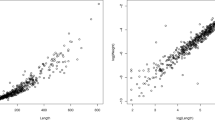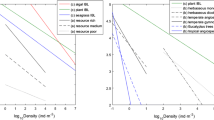Abstract
Eelgrass meadows play key roles in coastal ecosystems, and the extent of the standing biomass is focal to address ecosystem functioning. Eelgrass cover is commonly assessed in marine monitoring programs while biomass sampling is destructive and expensive. Therefore, we have proposed a functional relationship that translates eelgrass cover into aboveground biomass using site-specific information on Secchi depth or light attenuation. The relationship was estimated by non-linear regression on 791 combined observations of eelgrass cover and biomass from eight different coastal sites in Denmark. Eelgrass biomass initially increased with cover and flattened out as cover exceeded 40–50 % due to increased self-shading. Decreasing light energy with depth reduced the eelgrass biomass potential (assessed at 100 % cover), and this reduction was stronger for coastal sites with lower water transparency. Moreover, the biomass potential varied seasonally from around 110–140 g DW m−2 in spring months to a peak of 241 g DW m−2 in August, consistent with other seasonal studies. The model explained 56 % of the variation in log-transformed biomasses, but significant variation between coastal sites still remained, deviating between −23 and 39 % from the mean relationship. These site-specific deviations could be due to differences in losses related to grazing, drifting algae and epiphytes, better light capture by dense canopies, as well as differences in how well light conditions within eelgrass meadows are represented by actual measurements of Secchi depth and light attenuation. The relationship can be employed to estimate eelgrass biomass of entire coastal ecosystems from observations of eelgrass cover and depth.







Similar content being viewed by others
References
Carstensen, J. 2010. Censored data regression: statistical methods for analyzing Secchi transparency in shallow systems. Limnology & Oceanography: Methods 8: 376–385.
Carstensen, J., D.J. Conley, J.H. Andersen, and G. Ærtebjerg. 2006. Coastal eutrophication and trend reversal: a Danish case study. Limnology & Oceanography 51: 398–408.
Cebrián, J., C.M. Duarte, N. Marbà, and S. Enriquez. 1997. Magnitude and fate of the production of four co-occurring western Mediterranean seagrass species. Marine Ecology Progress Series 155: 29–44.
Clausen, K.K., P. Clausen, C.C. Faelled, and K.N. Mouritsen. 2012. Energetic consequences of a major change in habitat use: endangered Brent geese Branta bernicla hrota losing their main food resource. Ibis 154: 803–814.
Clausen, K.K., D. Krause-Jensen, B. Olesen, and N. Marbà. 2014. Seasonality of eelgrass biomass across gradients in temperature and latitude. Marine Ecology Progress Series 506: 71–85.
Duarte, C.M. 1991. Seagrass depth limits. Aquatic Botany 40: 363–377.
Duarte, C.M., and C.L. Chiscano. 1999. Seagrass biomass and production: a reassessment. Aquatic Botany 65: 159–174.
Duarte, C.M., N. Marbà, D. Krause-Jensen, and M. Sánchez-Camacho. 2007. Testing the predictive power of seagrass depth limit models. Estuaries and Coasts 30: 652–656.
Duarte, C.M., I.J. Losada, I.E. Hendriks, I. Mazarrasa, and N. Marbà. 2013. The role of coastal plant communities for climate change mitigation and adaptation. Nature Climate Change 3: 961–968.
Fourqurean, J.W., C.M. Duarte, H. Kennedy, N. Marbà, M. Holmer, M.A. Mateo, E.T. Apostolaki, G.A. Kendrick, D. Krause-Jensen, K.J. McGlathery, and O. Serrano. 2012. Seagrass ecosystems as a globally significant carbon stock. Nature Geoscience 5: 505–509.
Gallegos, C.L., P.J. Werdell, and C.R. McClain. 2011. Long‐term changes in light scattering in Chesapeake Bay inferred from Secchi depth, light attenuation, and remote sensing measurements. Journal of Geophysical Research 116: C00H08. doi:10.1029/2011JC007160.
Gutiérrez, J.L., C.G. Jones, J.E. Byers, K.K. Arkema, K. Berkenbusch, J.A. Commito, C.M. Duarte, S.D. Hacker, J.G. Lambrinos, I.E. Hendriks, P.J. Hogarth, M.G. Palomo, and C. Wild. 2011. Physical ecosystem engineers and the functioning of estuaries and coasts. Treatise on Estuarine and Coastal Science 7: 53–81.
Hemminga, M.A., and C.M. Duarte. 2000. Seagrass ecology. Cambridge: Cambridge University Press.
Koch, E.M. 2001. Beyond light: physical, geological, and geochemical parameters as possible submersed aquatic vegetation habitat requirements. Estuaries 24: 1–17.
Koenings, J.P., and J.A. Edmundson. 1991. Secchi disk and photometer estimates of light regimes in Alaskan lakes—effects of yellow color and turbidity. Limnology & Oceanography 36: 91–105.
Krause-Jensen, D., A.L. Middelboe, K. Sand-Jensen, and P.B. Christensen. 2000. Eelgrass, Zostera marina, growth along depth gradients: upper boundaries of the variation as a powerful predictive tool. Oikos 91: 233–244.
Krause-Jensen, D., M.F. Pedersen, and C. Jensen. 2003. Regulation of eelgrass (Zostera marina) cover along depth gradients in Danish coastal waters. Estuaries 26: 866–877.
Krause-Jensen, D., J. Carstensen, S.L. Nielsen, T. Dalsgaard, P.B. Christensen, H. Fossing, and M.B. Rasmussen. 2011. Sea bottom characteristics affect depth limits of eelgrass Zostera marina. Marine Ecology Progress Series 425: 91–102.
Marbá, N., D. Krause-Jensen, T. Alcoverro, S. Birk, A. Pedersen, J.M. Neto, S. Orfanidis, J.M. Garmendia, I. Muxika, A. Borja, K. Dencheva, and C.M. Duarte. 2013. Diversity of European seagrass indicators—patterns within and across regions. Hydrobiologia 704: 265–278. doi:10.1007/s10750-012-1403-7.
McGlathery, K.J., L.K. Reynolds, L.W. Cole, R.J. Orth, S.R. Marion, and A. Schwarzschild. 2012. Recovery trajectories during state change from bare sediment to eelgrass dominance. Marine Ecology Progress Series 448: 209–221.
Neckles, H.A., B.S. Kopp, B.J. Peterson, and P.S. Pooler. 2012. Integrating scales of seagrass monitoring to meet conservation needs. Estuaries and Coasts 35: 23–46. doi:10.1007/s12237-011-9410-x.
Nielsen, S.L., K. Sand-Jensen, J. Borum, and O. Geertz-Hansen. 2002. Depth colonization of eelgrass (Zostera marina) and macroalgaeas determined by water transparency in Danish coastal waters. Estuaries 25: 1025–1032.
Olesen, B. 1996. Regulation of light attenuation and eelgrass Zostera marina depth distribution in a Danish embayment. Marine Ecology Progress Series 134: 187–194.
Olesen, B., and K. Sand-Jensen. 1994. Biomass-density patterns in the temperate seagrass Zostera marina. Marine Ecology Progress Series 109: 283–291.
Pedersen, M.F., and J. Borum. 1993. An annual nitrogen budget for a seagrass Zostera marina population. Marine Ecology Progress Series 101: 169–169.
Pedersen, T.M., K. Sand-Jensen, S. Markager, and S.L. Nielsen. 2014. Optical changes in a eutrophic estuary during reduced nutrient loadings. Estuaries and Coasts 37: 880–892. doi:10.1007/s12237-013-9732-y.
Platt, T., and A.D. Jassby. 1976. The relationship between photosynthesis and light for natural assemblages of coastal marine phytoplankton. Journal of Phycology 12: 421–430.
Plummer, M.L., C.J. Harvey, L.E. Anderson, A.D. Guerry, and M.H. Ruckelshaus. 2013. The role of eelgrass in marine community interactions and ecosystem services: results from ecosystem-scale food web models. Ecosystems 16: 237–251. doi:10.1007/s10021-012-9609-0.
Rasmussen, J.R., M.F. Pedersen, B. Olesen, S.L. Nielsen, and T.M. Pedersen. 2013. Temporal and spatial dynamics of ephemeral drift-algae in eelgrass, Zostera marina, beds. Estuarine Coastal Shelf Science 119: 167–175.
Rasmussen, J.R., K. Dromph, C. Göke, and D. Krause-Jensen. 2015. Reduced cover of drifting macroalgae following nutrient reduction in Danish coastal waters. Estuaries and Coasts. doi:10.1007/s12237-014-9904-4.
Riisgård, H.U., P.B. Christensen, N.J. Olesen, J.K. Petersen, M.M. Møller, and P. Andersen. 1995. Biological structure in a shallow cove (Kertinge Nor, Denmark)—control by benthic nutrient fluxes and suspension-feeding ascidians and jellyfish. Ophelia 41: 329–344.
Sand-Jensen, K. 1975. Biomass, net production and growth dynamics in an eelgrass (Zostera marina L.) population in Vellerup Vig, Denmark. Ophelia 14: 185–201.
Sand-Jensen, K., and J. Borum. 1991. Interactions among phytoplankton, periphyton, and macrophytes in temperate freshwaters and estuaries. Aquatic Botany 41: 137–175.
Sand-Jensen, K., T. Binzer, and A.L. Middelboe. 2007. Scaling of photosynthetic production of aquatic macrophytes—a review. Oikos 116: 280–294. doi:10.1111/j.2006.0030-1299.15093.x.
van der Heide, T., E.H. van Nes, M.M. van Katwijk, H. Olff, and A.J.P. Smolders. 2011. Positive feedbacks in seagrass ecosystems—evidence from large-scale empirical data. PLoS ONE 6(1): e16504. doi:10.1371/journal.pone.0016504.
Acknowledgments
We are grateful to Nikolaj Holmboe, Steen Schwaerter, Jens Sund Laursen, Mikael Hjort Jensen, and Martha Laursen from the local departments of the Danish Nature Agency for their help on providing data and background information on eelgrass in the various coastal areas. We thank three anonymous reviewers and the associate editor for their constructive comments that improved the manuscript. The study received support from the Danish Nature Agency, the DEVOTES project funded under the EC 7th framework program (grant agreement no. 308392) and the COCOA project under the BONUS research program funded by the EC and the Danish Research Council.
Author information
Authors and Affiliations
Corresponding author
Additional information
Communicated by Alberto Vieira Borges
Electronic Supplementary Material
Below is the link to the electronic supplementary material.
ESM 1
(JPEG 1156 kb)
Rights and permissions
About this article
Cite this article
Carstensen, J., Krause-Jensen, D. & Balsby, T.J.S. Biomass-Cover Relationship for Eelgrass Meadows. Estuaries and Coasts 39, 440–450 (2016). https://doi.org/10.1007/s12237-015-9995-6
Received:
Revised:
Accepted:
Published:
Issue Date:
DOI: https://doi.org/10.1007/s12237-015-9995-6




